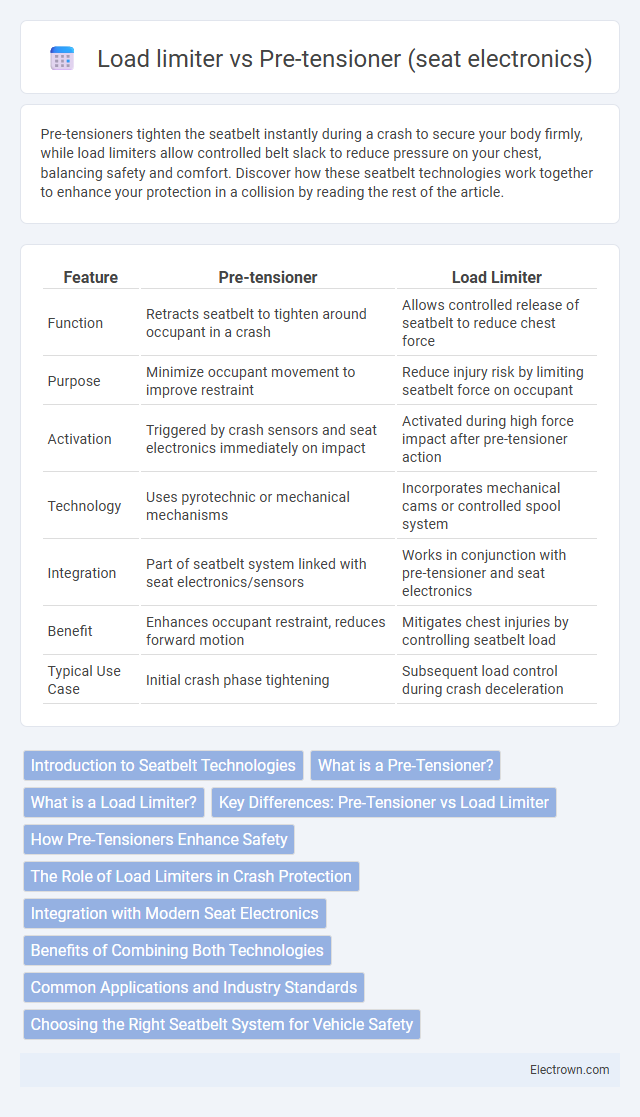Pre-tensioners tighten the seatbelt instantly during a crash to secure your body firmly, while load limiters allow controlled belt slack to reduce pressure on your chest, balancing safety and comfort. Discover how these seatbelt technologies work together to enhance your protection in a collision by reading the rest of the article.
Table of Comparison
| Feature | Pre-tensioner | Load Limiter |
|---|---|---|
| Function | Retracts seatbelt to tighten around occupant in a crash | Allows controlled release of seatbelt to reduce chest force |
| Purpose | Minimize occupant movement to improve restraint | Reduce injury risk by limiting seatbelt force on occupant |
| Activation | Triggered by crash sensors and seat electronics immediately on impact | Activated during high force impact after pre-tensioner action |
| Technology | Uses pyrotechnic or mechanical mechanisms | Incorporates mechanical cams or controlled spool system |
| Integration | Part of seatbelt system linked with seat electronics/sensors | Works in conjunction with pre-tensioner and seat electronics |
| Benefit | Enhances occupant restraint, reduces forward motion | Mitigates chest injuries by controlling seatbelt load |
| Typical Use Case | Initial crash phase tightening | Subsequent load control during crash deceleration |
Introduction to Seatbelt Technologies
Pre-tensioners in seatbelt systems swiftly retract slack during a collision, reducing occupant movement and enhancing safety. Load limiters manage the force exerted by the seatbelt on the occupant by allowing controlled webbing release, minimizing injury risk from excessive pressure. Understanding the complementary roles of pre-tensioners and load limiters helps you appreciate advancements in seatbelt technologies designed to optimize occupant protection.
What is a Pre-Tensioner?
A pre-tensioner is a safety device in automotive seat belts designed to tighten the belt immediately upon detecting a collision, reducing occupant movement. It works by retracting the belt to remove slack, ensuring the passenger is securely restrained before the full force of impact occurs. Pre-tensioners are often integrated with load limiters, which manage the force applied on the occupant to minimize injury.
What is a Load Limiter?
A Load Limiter in seat electronics is a safety device designed to reduce the force exerted by a seatbelt on the occupant during a collision, preventing excessive injury. It works by allowing controlled webbing payout once a certain force threshold is reached, helping to manage occupant kinematics more effectively. You benefit from Load Limiters as they complement Pre-tensioners by balancing restraint forces during a crash for enhanced protection.
Key Differences: Pre-Tensioner vs Load Limiter
Pre-tensioners tighten seat belts instantly upon detecting a collision, reducing occupant forward movement and improving restraint effectiveness. Load limiters control the force exerted by the seat belt on the occupant by gradually releasing webbing to prevent excessive chest injuries during impact. The key difference lies in their function: pre-tensioners focus on minimizing slack and securing occupants tightly, while load limiters manage belt tension to balance protection and injury reduction.
How Pre-Tensioners Enhance Safety
Pre-tensioners enhance safety by instantly tightening the seatbelt during a collision, reducing the slack and firmly securing Your body to minimize movement. This rapid response helps prevent injuries by positioning occupants correctly for airbag deployment. By working in tandem with load limiters, pre-tensioners ensure optimal restraint force, balancing safety and comfort effectively.
The Role of Load Limiters in Crash Protection
Load limiters play a crucial role in crash protection by controlling the force exerted on occupants during a collision, preventing injuries caused by excessive seatbelt tension. Unlike pre-tensioners, which tighten the seatbelt immediately upon impact to secure the passenger, load limiters gradually release webbing to reduce chest trauma. The combined function of pre-tensioners and load limiters optimizes occupant safety by balancing restraint and force absorption.
Integration with Modern Seat Electronics
Pre-tensioners and load limiters are crucial components integrated into modern seat electronics to enhance occupant safety by managing seatbelt forces during a crash. Pre-tensioners tighten the seatbelt instantly upon collision detection through electronic sensors, reducing occupant movement, while load limiters control the force applied to the chest by allowing a controlled release of belt webbing. Your vehicle's advanced seat electronics ensure seamless communication between these devices and the airbag system, optimizing protection during impact scenarios.
Benefits of Combining Both Technologies
Combining pre-tensioner and load limiter technologies in seat electronics significantly enhances passenger safety by optimizing seatbelt performance during collisions. The pre-tensioner tightens the seatbelt instantly to secure Your body firmly in place, while the load limiter reduces the force exerted on the chest by allowing controlled belt webbing release. This synergy reduces the risk of injury by minimizing forward movement and distributing crash forces more effectively, delivering a balanced restraint system that improves overall occupant protection.
Common Applications and Industry Standards
Pre-tensioners and load limiters are critical components in automotive seatbelt systems, commonly applied in passenger vehicles to enhance occupant safety during collisions. Pre-tensioners rapidly retract seatbelts upon impact, minimizing slack and ensuring optimal restraint, while load limiters control the force exerted on the occupant by allowing controlled seatbelt payout to reduce chest injuries. Industry standards such as FMVSS 208 in the United States and UNECE Regulation 16 in Europe mandate the integration and performance criteria of these devices to meet stringent occupant protection requirements.
Choosing the Right Seatbelt System for Vehicle Safety
Pre-tensioners in seatbelt systems rapidly tighten the belt upon impact, reducing occupant movement and improving crash protection, while load limiters allow controlled belt slack to minimize chest injuries by managing the force exerted on the occupant. Selecting the right seatbelt system depends on your vehicle's safety requirements and crash dynamics, ensuring a balance between restraint firmness and injury mitigation. Understanding the distinct roles of pre-tensioners and load limiters helps optimize occupant safety by combining immediate restraint adjustment with impact force control.
Pre-tensioner vs Load limiter (seat electronics) Infographic

 electrown.com
electrown.com